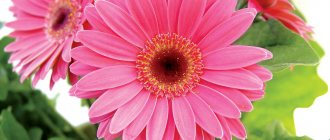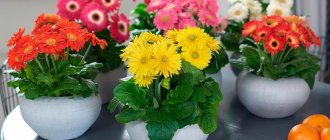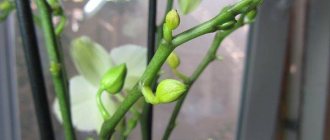Types and varieties of indoor gerberas
Each modern variety is a hybrid gerbera , which is bred from 2 species: the classic green-leaved and Jameson.
Varieties that have compact and low stems are suitable for the windowsill, these are:
- Festival - in the photo you can see that it has a short stem, and even larger flowers that have a variety of shades.
- Aldebaran and Alcor - they have small flowers and narrow leaves.
- Jupiter, Vega, Migar - they have narrow leaves and medium-sized flowers.
- A mix is a combination of many varieties with flowers of different shades.
How to grow gerberas from seeds?
To successfully grow potted gerbera from seeds, you must follow 8 important rules:
- Choose high-quality genetic material (seeds) ...
- Make sure you have a quality substrate...
- Maintain a stable watering regime...
- Provide high levels of illumination...
- Regularly feed plants with complex fertilizers
Oct 13
2014 Interesting materials:
In what year and where did the Olympics take place in Russia? In what year and where did the Winter Olympic Games begin? In what year and what school did Alla Pugacheva graduate from? In what year did Emperor Constantine move the capital from Rome to the small town of Byzantium? In what year did Ireland become independent? In what year did Yuri Dolgoruky seize full power in Kyiv? In what year did Ivan 3 annex Novgorod? In what year was Filaret elected patriarch? In what year was electricity invented in Russia? In what year was ice cream invented?
Indoor gerbera: care at home
Growing a crop on a windowsill is quite simple, you just need to follow agricultural techniques, and you can grow a wide variety of varieties yourself.
The soil in which the plant is sold is not always suitable for its long-term cultivation, so the gardener is faced with the question of how to replant the gerbera after purchase.
It is not recommended to add compost or fresh humus to the substrate.
Holes for drainage should be made in the prepared container, pour expanded clay onto the bottom, and then soil from 2 parts of leaf soil, and 1 part each of peat soil and sand.
After replanting, water the plant generously along the edge of the pot, so as not to get it on the foliage. Water with warm water. If water collects in the pan, drain it.
Lighting and temperature conditions
Gerbera in a pot prefers sunlight and fresh air . Because of this, the room where the flowers stand needs to be ventilated more often, but make sure that there is no draft wind.
The temperature in the room in summer should be +16-20°C, and in winter, when the culture is at rest, then +12-14°C.
Gerbera naturally grows in the tropics, so it tolerates heat more easily than cold . In winter, a pot with a plant can be placed on a glazed loggia with an air temperature of +12-14°C, but for a short time. It is not recommended to radically change the temperature, as this reduces the flower’s resistance.
Watering
Home gerbera loves water ; water it often, but not too much, as the rhizomes may begin to rot.
Water, being careful not to get it on the leaves.
But it’s even better if you pour the water into the tray and drain the excess from it a few minutes after the gerbera has absorbed the moisture. Water for irrigation should have a temperature of +20°C. In winter, water the crop less often.
Air humidity
Since it is impossible to spray the crop from a spray bottle , because moisture should not get on the leaves, you can purchase an air humidifier. It is also good to place wide basins of water near the gerbera. Or you can pour wet pebbles into the tray.
Fertilizer application
Organic matter cannot be added. Therefore, buy fertilizer Forte, Biosad or others. From April to August, the crop is fed once every 3 weeks. When the buds open, the crop is fed with a composition containing a large amount of potassium .
And during dormancy - a mixture with a large amount of nitrogen . The fertilizer is heavily diluted with water to obtain a weakly concentrated solution.
Transplantation and soil requirements
The plant is replanted in autumn or winter. For transplantation, choose a container that is 2-3 cm larger in diameter.
If you decide to make the substrate yourself, then mix sand, humus, peat and turf soil in equal parts, add 2 parts of leaf soil and a little perlite.
Diseases and pests
Do not overwater the plant, otherwise the rhizomes will rot, and then the leaves and stem will begin to rot.
The plant may get gray rot. At the same time, a grayish coating is visible on the base of the foliage, peduncles, and flowers, and gradually the entire gerbera fades. If you find gray rot, then spray the plant with Fundazol, Rovral.
Powdery mildew may appear on young flowers. When the disease occurs, a whitish coating is noticeable on the petioles of the foliage. Then the plaque spreads to flowers, buds, and eventually the plant dies.
Attention! With excessive watering, the crop may become infected with late blight. If the air is too dry, spider mites may appear on the flower.
To cure a plant from diseases, spray it with Topaz or Fundazol.
Do I need to feed
It is not recommended to feed a gerbera in a pot after purchasing it in a store. The fact is that flowers are sold in peat, which manufacturers often saturate with various additives. If you add fertilizer to peat, the roots of the plant may burn.
Don't worry that your gerbera will wilt from lack of nutrition. Soon you will still be replanting the gerbera in nutritious soil. When and correctly to transplant read below.
For the first time at home, gerberas are fed two months after transplantation with fertilizers for flowering indoor plants or special fertilizers for gerberas.
Main problems when growing
Why do the leaves turn yellow?
With Alternaria blight, brownish spots are visible on the foliage.
Then the leaves begin to turn pale and turn yellow.
Also, with mosaic, yellowish-green spots appear, and then leaf necrosis develops.
It is best to treat gerbera with Radomil Gold.
This video once again shows how to properly care for indoor gerberas:
How to achieve lush flowering
Despite its love for bright sun, the plant stops blooming if there is too much light. Gerbera needs no more than 12 hours of daylight. It blooms most luxuriantly from late August to November.
If a gerbera does not bloom for more than 3 months, this means that the reason is not the light, but something else. A plant may stop forming buds if it is planted in a pot that is too large for it, then the crop directs all its energy to the growth of rhizomes. If you put nitrogen under the gerbera, it will also stop flowering.
Diseases and pests
When growing gerbera indoors, a gardener may encounter the following problems:
- The leaves are turning pale . This happens when the lighting is too intense. In order to avoid this in the spring and autumn, the bushes should be shaded from the midday rays of the sun.
- The bush looks painful . A bush becomes infected with a fungal disease when there is excessively high humidity and poor ventilation.
- The leaves are brightening . If a flower recently purchased in a store begins to lose its bright color, this may be due to its adaptation to new conditions or poor lighting. As a rule, purchased plants lose their brightness. This is due to the fact that flowers grown for sale are often fed with special substances that make the color of their foliage more saturated.
- Withering and death of a flower . Make sure that there is no stagnation of liquid in the root system, as this can cause the death of the gerbera. Particular attention should be paid to watering in the cold season.
- Harmful insects . Whiteflies, mites, aphids and scale insects can settle on the flower.
Reproduction of gerbera at home
Gerbera can be propagated by seeds, dividing the bush and cuttings.
Propagation by seeds
When you buy seeds, read the expiration date on the bag. The seeds remain viable for 8 months from the time of collection. It is best to sow in spring.
Step-by-step sowing instructions:
Mix equal parts of sand, peat and leaf soil, and perlite. The resulting soil should be loose and light.- Pots intended for sowing seeds must have holes for drainage; pour expanded clay into them with a layer of 3 cm.
- Next, lay the prepared substrate and compact it.
- Place the seeds on the surface of the ground and press them down a little, then sprinkle with sand.
- Place the pot in a warm room with an air temperature of 16-20°C.
- Ventilate the pot 2 times a day; the soil must be moistened all the time, so water it constantly.
- After 8-12 days you will see the first shoots. When the foliage grows, plant the seedlings into separate larger pots. There should be a distance of 8 cm between seedlings.
- When 5-6 leaves grow, the seedlings are transferred to containers with a diameter of 10 cm. First, make soil for them from 1 part of sand, humus, peat and turf soil, 2 parts of leaf soil and add a little perlite.
- When the gerberas grow up, they are transplanted into pots with a diameter of 15-20 cm.
Reproduction by dividing the bush
Choose a bush that is 3-4 years old. The plant should grow to several bushes. Separate one.
Plant it in a container, and in six months it will grow a rhizome.
Reproduction by cuttings
Choose a young plant that is not yet 3 years old.
Cut off the part of its stem that has a leaf and a node. Plant the cuttings in warm and moist soil and cover with film. Don't forget to water. Within a week, new shoots will grow. Then transplant the crop into a new pot.
If you follow the correct agricultural practices when caring for the plant, it will bloom luxuriantly and not get sick. Don't water the flower too much, but do it often.
Reproduction
You can get new gerbera specimens in various ways:
- seeds;
- cuttings;
- dividing the bush.
You can try any of them.
Seeds
If you have time to tinker, you can try this method. Do this from January to early April. Fill the container with the peat mixture, water it well, spread the seeds on the surface of the soil and cover with glass.
After about 20 days, shoots should appear. When the seedlings have 4-6 leaves, plant the sprouts in separate flowerpots. After a month, do the first feeding. Flowers should appear in about 10 months.
Cuttings
This method is much simpler than the previous one. Done in May-June. From the main bush, cut a cutting with a couple of leaves. Make sure there is a growth node and some roots. Plant it in a pot. Cover with a bag and place in a warm place in the light. Constantly ventilate and water the sprouts. When the plant takes root, replant.
Dividing the bush
If you want to guarantee the preservation of varietal characteristics, use bush division. Do this in March or April. Remove a bush that is three or more years old from the flowerpot. Treat with potassium permanganate. Trim the roots and divide into several parts. Each division must have at least two growth points.
Where to plant gerbera
Remembering the homeland of this flower, it is not difficult to guess that the gerbera is accustomed to sunlight and long days. This does not mean that you can put it in the sun on a hot afternoon. The window sills of those windows that face east and west are best suited. If the location of your apartment is such that this is impossible, then on the southern windows it is necessary to slightly shade the gerbera during the sunniest hours, and on the northern windows you may have to provide it with an additional light source.
As for the temperature regime, 20-22º C is the temperature that indoor gerbera loves. Care at home, standard conditions for the middle zone, presupposes just such a temperature regime, so there is no need to be particularly clever here. Frequent ventilation is encouraged: fresh air will be useful not only for your household, but also for your pet. In the summer she will be very comfortable on the balcony, loggia or on the porch of a private house, but she will not like temperature changes, so it is better to return the flower pot indoors at night.
In spring, all plants come to life, and indoor gerberas also wake up from hibernation. It will require the same care as before the dormant period. You can replant it if the roots of the flower have already protruded on the surface of the ground, but if there is no special need, then you can not disturb the plant by replanting until the fall and the end of the flowering period. If you provide it with the right conditions, the gerbera, having gained strength during the winter rest, will definitely begin to bloom. In summer, due to too high temperatures, the growth and flowering of the plant will slow down somewhat, and at the end of summer the gerbera will bloom again.
How to properly plant indoor flowers in a pot
Proper planting of flowers in pots is much easier than planting crops in open ground. But, despite all the simplicity, there are certain planting rules.
To make your flowers comfortable, you need not only to choose a suitable container, but also to prepare high-quality soil for the flowers. If you already have a pot, check that there are drainage holes in the bottom through which excess moisture will drain from the soil. If there are no such holes, you will have to make them yourself.
The further stages of planting in pots will be as follows (Figure 3):
- Laying a layer of drainage on the bottom of the container, and it is not necessary to buy drainage. You can make it yourself from broken bricks, small stones or moss collected from the forest.
- Filling the pot with soil mixture: It is advisable to add a layer of soil that will only fill the pot halfway. In this case, you can freely place a seedling in it.
- Planting a seedling is carried out as follows: a flower with wet roots is placed in a pot strictly vertically, its root system is distributed so that it is free in the pot and the roots are sprinkled with the remaining soil. After this, the soil needs to be lightly compacted and watered.
Figure 3. Stages of planting indoor plants in pots
This is where planting or replanting an indoor flower ends. Successful cultivation will require periodic watering (frequency depends on the variety), fertilizing, as well as ensuring optimal temperature and humidity conditions. Some species tolerate the moderate humidity of an ordinary city apartment well, while others require additional moisture, which can be provided by regular spraying of the leaves.
The technology for planting indoor plants in pots is shown in the video.
Choosing a pot
It is important not only to know how to plant indoor plants correctly, but also what containers should be used for this. Modern manufacturers offer a wide selection of pots in a wide variety of shapes, sizes and styles, so you can easily choose the right container (Figure 4)
Figure 4. Types of flower pots
Experienced flower growers recommend being guided not so much by taste preferences as by the practical side. Firstly, the pot must be spacious enough for a particular variety so that the root system of the flower can be freely placed inside. Secondly, there should be drainage holes in the bottom of the container through which excess moisture will drain from the soil. In addition, the potty should be durable and comfortable.
Peculiarities
Since the modern market offers a wide variety of pots made of various materials, we present the features of clay, plastic and other containers for indoor flowers.
From an environmental point of view, clay pots are considered the best. They do not emit toxic substances, therefore they are absolutely safe for human and plant health. However, such containers are easily broken and may crack after prolonged use. In addition, they are heavy, so it will be difficult to move pots freely, especially large ones.
Plastic pots are very light, beautiful and elegant. They are easy to wash and rearrange if necessary. But when buying such a pot, be sure to keep in mind that the plastic used to make it releases harmful substances into the soil and air that can harm not only plants, but also people.
Rules for planting and caring for indoor flowers in a pot
In previous sections, we have already looked at the rules for planting crops in pots. Therefore, let us dwell in more detail on caring for flowers for the home (Figure 5). In this matter, you should be guided by the characteristics of each variety. For example, exotic tropical flowers require intensive watering and moisture, while cacti, on the contrary, do not tolerate excess moisture well.
Figure 5. Basic stages of caring for indoor crops
In addition, home flowerpots require periodic feeding, which is applied by watering at the root or spraying the leaves. In winter, it is necessary to provide additional lighting to the flowers, and during cultivation it is necessary to periodically inspect for the presence of pests or symptoms of diseases in order, if necessary, to carry out preventive spraying.
Frequency of fertilizing and transplanting
Gerbera is demanding on nutrition, so it needs regular feeding. They are carried out every 10 days, and the concentration of the solution should be two times lower. As for fertilizers, it is better to use ready-made mineral complexes. At different stages of development, gerbera needs different nutrients, namely:
- from mid-winter to mid-spring, nitrogen should predominate in fertilizing;
- from summer to autumn, when the bush blooms, preparations containing potassium are used.
Gerbera does not tolerate organic matter.
Home gerberas are replanted annually in the spring. This should be done using the transshipment method so as not to damage the roots.
How to water a flower?
One of the dangers of keeping domestic gerberas is fungal diseases of the root system. Most often they occur due to improper watering. Although gerberas love moisture, they will not forgive its excess in the soil. You can water either through the tray or along the edge of the flowerpot. Excess water that flows into the saucer should be drained. Cold water cannot be used. You can periodically spray the bush, but only the leaves. Water getting into the outlet and onto the flowers is unacceptable.
Since gerbera loves high humidity, it is advisable to place the pot on a tray with water.
General information about gerbera
Gerbera belongs to the Aster family of the genus of perennial herbs. It is not surprising that in appearance it very much resembles an aster. In the wild, gerbera grows on the island of Madagascar and in the southern part of the African continent. The plant was first noticed by Europeans at the beginning of the eighteenth century. Dutch botanist Jan Gronovius named the plant after his German colleague, the famous scientist Traugott Gerber; The flower is still known under this name.
Gerbera is widely used as a decorative ornament.
The plant was already compared to chamomile or daisy. Gerbera is indeed very similar in appearance to the above-mentioned plants, since it also belongs to the Asteraceae family. Each flower has dense rows of elongated, narrow petals of bright color. The plant is not medicinal, but is widely used as a decorative ornament.
Gerbera is of great economic importance to many flower exporting countries. It is known that in 2008 this crop took fifth place in the total sales of plants for bouquets
It was surpassed only by such expected contenders as rose, tulip, chrysanthemum and carnation. And this result is not at all accidental. The plant stands well in a vase and can be displayed in a prominent place for up to three weeks. But for this it is better to pour a little water into the vase.
Features of transplanting azaleas in the garden
Transplantation or planting of a street representative in the garden is carried out in early spring, before active sap flow. As a last resort, transplanting the species can be postponed to the beginning of autumn. Street azalea has shallow roots, which is why it does not require a deep hole for planting. Depth - no more than 50 cm, width - 70-80 cm. The bottom of the seat is covered with a thick layer of broken brick or gravel.
Garden varieties
On a note! When lime chips are added to the soil, the acidity of the soil gradually changes. This is harmful to azaleas.
The soil should consist of nutritious soil, peat, humus and river sand. The landing of a street representative is no different from an indoor one. The root collar of the transplanted plant should be located above ground level. After planting, the soil is compacted and moistened.
Compositions with gerbera
The great advantage of gerberas is that they are not associated with a specific event or symbolism. These are flowers of universal use. They can appear in all events - from wedding bouquets to funeral arrangements. And no one will blame us for using this flower. It is also worth mentioning that varieties with large inflorescences are ideal for large compositions (for example, in a flower bed), since a relatively small number of plants is enough to fill a large space.
Bouquet of gerberas
Red roses tell us about our deep feelings, lilies of the valley are a symbol of innocence and shyness. It is difficult to compare a gerbera with a rose, but its beauty cannot be denied. In addition, the flower itself is a sign of the highest respect and admiration. This makes bouquets of gerberas popular as gifts for teachers at the end of the school year or for doctors for their help. All in all, they are quite a worthy gift for all those who deserve our special recognition. That is why these seemingly inconspicuous flowers are so readily chosen for bouquets that we give to someone on special occasions.
Ideal flowers for a wedding
Respect and admiration are also the exceptional meaning of the fact that gerberas are very often chosen as a wedding bouquet. In addition, even if the young couple does not know the secret language of flowers, the beauty of gerberas will give the newlyweds a lot of joy. Beautiful flowers and fresh fruits in a basket are a fantastic idea if you want to make a big impression and surprise. Lilies and gerberas are an aromatic mixture that, thanks to fresh fruit, will acquire a unique character and highlight their beauty. You can not only admire this gift, but also taste it (of course, the edible part of it). Feel free to choose a floral arrangement with fruit.
Tropical composition
This is a basket with gerberas, sprigs of roses, carnations and ivy. Enchant your loved ones with the beautiful meaning of flowers and be with them with all your heart. They will definitely understand and receive your bouquet with joy.










